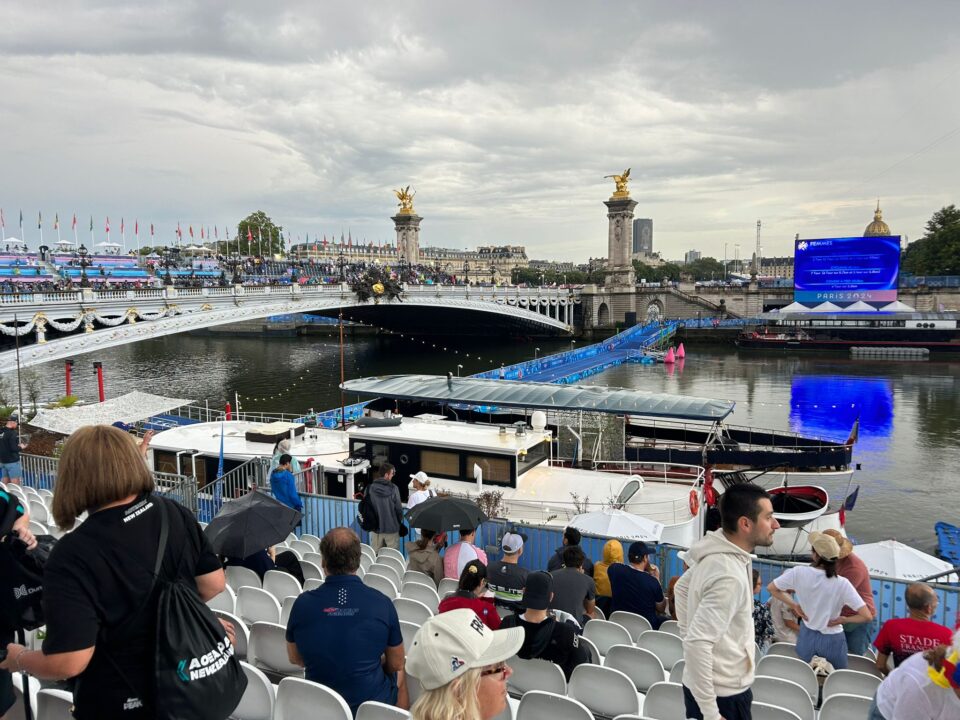2024 PARIS SUMMER OLYMPIC GAMES
- Pool Swimming: July 27 – August 4, 2024
- Open Water Swimming: August 8 – 9, 2024
- La Défense Arena — Paris, France
- LCM (50 meters)
- Meet Central
- Full Swimming Schedule
- SwimSwam Preview Index
- Pick ’em Contest
- How To Watch
- Entry Lists
- Live Results
- Prelims Live Recaps: Day 1 | Day 2 | Day 3 | Day 4
- Finals Live Recaps: Day 1 | Day 2 | Day 3 | Day 4
Despite concerns about water quality in the Seine River leading to various practice cancellations and the postponement of the men’s race, the women’s triathlon went off without a hitch early Wednesday morning.
Athletes started racing at 8 AM in Paris (2 AM EST), with the 1500m swim marking the first leg of the event.
The women’s triathletes were the first athletes to swim in the Seine at the #ParisOlympics. 🏊♀️👀 pic.twitter.com/0630dGeOU9
— NBC Sports (@NBCSports) July 31, 2024
When all was said and done, Frenchwoman Cassandre Beaugrand crossed the finish line first in front of a home crowd in a time of 1:54:55, becoming the first French person to ever medal in the event. Switzerland’s Julie Derron and Great Britain’s Beth Potter rounded-out the podium.
The swim in the Seine comes as a historic moment for the nation of France. Deemed “unswimmable” for years, the Seine has long been a topic of debate amongst the French public. When the government, in combination with Paris 2024 Organizers, announced a $1.5 billion clean-up effort, many were skeptical about the ability to make the Seine safe to swim in. Despite the clean-up, tests taken just a month from the Olympics showed E. coli levels at 10 times the acceptable limit for swimming. However, reduced rainfall levels throughout the month of July contributed to a sharp decline in bacteria levels, leading Paris Mayor Anne Hidalgo to take a plunge into the river before the start of the Games.
With conditions in the river improving, organizers were optimistic that the triathlon and open water events would be able to occur without issue, but recent downpours increased bacteria levels once-again. As a result, several triathlon training sessions were canceled early in the week, along with the men’s race being postponed. Despite the hiccups, it appears as through bacteria levels have returned back under safe-swimming levels.
Aurelie Merle, the Paris 2024 Director of Sports, said Tuesday that testing results showed “we’re very close to the threshold of triathlon,” noting that one of four test sites along the triathlon course was below the threshold for E. coli. Two other sites were just above the limit, and one was more elevated, she said, citing a range of 980 to 1,553.
World Aquatics requirements for inland waterways:
- Enterococci score: <200 is Excellent; <400 is Good; >400 is Unacceptable
- E. Coli score: <500 is Excellent; <1,000 is Good; >1,000 is Unacceptable
World Triathlon requirements for inland waterways:
- Enterococci score: <200 is Excellent; <400 is Good; <330 is Sufficient
- E. Coli score: <500 is Excellent; <1,000 is Good; <900 is Sufficient
The men’s triathalon will also occur today, with athletes slated for a 10:45 AM start in Paris. Assuming conditions remain stable, open water swimming will take over the Seine on August 8 and 9.

How many days until e coli is ravaging the athlete village?
Can someone explain the sufficient description? Like why is it less than the “good” category?
https://dims.apnews.com/dims4/default/cd7c5aa/2147483647/strip/true/crop/2122×3183+0+0/resize/798×1198!/format/webp/quality/90/?url=https%3A%2F%2Fassets.apnews.com%2F%5B-%2F66%2F%2C%2038%2C%20-45%2C%20-107%2C%20-79%2C%20-28%2C%2041%2C%20-52%2C%20-22%2C%20-72%2C%20-61%2C%20-48%2C%20-31%2C%2041%2C%20-62%2C%2070%2C%20-45%2C%2079%2C%20-25%2C%2065%2C%2034%2C%20-8%2C%20-29%2C%20123%2C%2021%2C%20-86%2C%2044%2C%20127%5D%2F2609f28e6ae44b95bb2fbf29da72b420
I can smell it an ocean away…
And get prophylaxis
Great finish for Alex Yee. Timed it perfectly.
Ewwwwwwwww🤢☣️
Open swimmers and triathletes swallow on average about half a litre of water
It looks like they took the level criteria as a suggestion rather than a rule. Another article said E. Coli levels were good in one spot yesterday but just over in 2 spots and 1500 in a 4th spot. And that was yesterday. I didn’t realize these weren’t hard and fast rules.
From the ESPN article “But experts stressed that these numbers are simply guidelines used to assess risk.”
So, it’s interesting, as someone who works in environmental biology, I looked into this a few weeks ago. They’re using upstream monitoring to detect the bacteria levels and project when those bacteria levels will be reflected further downstream. It appears that they’re using devices that allow for real time tracking in those upstream locations. However, I don’t necessarily know how reliable those devices are nor what brand of device they are using. At the quickest turn-around time, we won’t know the actual bacteria levels from laboratory testing for at least 24 hours as there’s a 23-72 hour incubation window.
In the US, many environmental agencies will close beaches if the bacteria counts even approach 200 colony-forming units (CFUs) per… Read more »
I don’t believe for a moment that levels were normal.
Over under on swimmers getting E-coli?
They are in great health so unlikely.
Sometimes athletes seem to catch bugs easier than the average relatively healthy person.
Good training means controlled fatigue, but this fatigue can also increases your odds of catching something
A quick googlefu confirmed my suspicion that the occurence of autoimmune disorders in athletes is pretty common actually, which for those who don’t know that’s a condition where the problem isn’t the bug, it’s that in response to the big the immune ayatem goes haywire and starts attacking the body itself. I’m pretty sure drinking a lot of e. coli is not a good pairing with that
athletes get sick easier than “normal” healthy young people due to constant training stress and fatigue